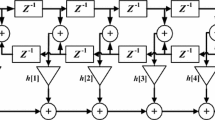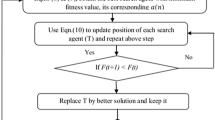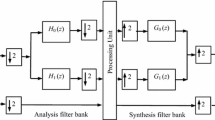Abstract
This paper presents a novel low complex configuration methodology by deploying a directed minimal spanning tree (DMST) algorithm for designing digital multiplierless finite impulse response filter. This method utilizes the shift inclusive differential coefficient and common sub-expression elimination (CSE) technique to minimize the multiple constant multiplications using steepest decent approach. The attractive feature of this work lays on the detailed comparison of the cost, reconstruction error, pass-band and stop-band error by exploiting various evolutionary techniques such as cuckoo search algorithm, particle swarm optimization, artificial bee intelligence, hybrid swarm optimization and flower pollination algorithm; followed by employing hybrid SID and DMST on these techniques. For this purpose, a mean squared error-based objective function is optimized in the pass-band and stop-band region of the filter. Further, a detailed comparison of hybrid SID and DMST with other existing CSE algorithms is also illustrated. It has been observed that up to 80% reduction in number of adders can be accomplished using the proposed DMST-based approach for multiplierless filter design.








Similar content being viewed by others
References
S. Aldossary, M.G. Martin-Khan, N.K. Bradford, A.C. Smith, A systematic review of the methodologies used to evaluate telemedicine service initiatives in hospital facilities. Int. J. Med. Inform. 97(1), 171–194 (2017)
A. Bindal, S. Kumar, A. Kumar, Denoising of electroencephalogram signals using digital signal processor. Adv. Res. Electr. Electron. Eng. 1(1), 38–41 (2014)
T. Bindima, E. Elias, A novel design and implementation technique for low complexity variable digital filters using multi-objective artificial bee colony optimization and a minimal spanning tree approach. Eng. Appl. Artif. Intell. 59(3), 133–147 (2017)
A. Chandra, S. Chattopadhyay, A novel approach for coefficient quantization of low-pass finite impulse response filter using differential evolution algorithm. SIViP 8(7), 1307–1321 (2014)
H. Choo, K. Muhammad, K. Roy, Complexity reduction of digital filters using shift inclusive differential coefficients. IEEE Trans. Signal Process. 52(6), 1760–1772 (2004)
P. Das, S.K. Naskar, S.N. Patra, Hardware efficient FIR filter design using global best steered quantum inspired cuckoo search algorithm. Appl. Soft Comput. 71(10), 1–19 (2018)
S. Dhabal, P. Venkateswaran, An improved global-best-driven flower pollination algorithm for optimal design of two-dimensional FIR filter. Soft. Comput. 23(18), 8855–8872 (2019)
A.K. Dwivedi, S. Ghosh, N.D. Londhe, Low power FIR filter design using modified multi-objective artificial bee colony algorithm. Eng. Appl. Artif. Intell. 55(10), 58–69 (2016)
R.I. Hartley, Subexpression sharing in filters using canonic signed digit multipliers. IEEE Trans. Circuits Syst. II Analog Digit. Signal Process. 43(10), 677–688 (1996)
Y. Jang, S. Yang, Low-power CSD linear phase FIR filter structure using vertical common sub-expression. Electron. Lett. 38(15), 777–779 (2002)
K.Y. Jheng, S.J. Jou, A.Y. Wu, A design flow for multiplier-less linear-phase FIR filters: from system specification to Verilog code, in Proceedings of the 2004 International Symposium on Circuits and Systems (ISCAS’04), vol. 5 (2004), p. V-293-296
J.Y. Kaakinen, T. Saramaki, A systematic algorithm for the design of multiplierless FIR filters. IEEE Int. Symp. Circuits Syst. 2, 185–188 (2001)
S. Kalathil, E. Elias, Design of multiplier-less sharp non-uniform cosine modulated filter banks for efficient channelizers in software defined radio. Int. J. Eng. Sci. Technol. 19(1), 147–160 (2016)
A.F. Kamaruzaman, A.M. Zain, S.M. Yusuf, A. Udin, Levy flight algorithm for optimization problems—a literature review. Appl. Mech. Mater. 421, 496–501 (2013)
L. Li, Y. Si, Remote sensing image enhancement based on nonsubsampled shearlet transform and local Laplacian filter, in IEEE 3rd International Conference on Image, Vision and Computing (ICIVC), vol. 3 (2018), pp. 415–418
H. Liu, A. Jiang, Efficient design of FIR filters using common subexpression elimination, in 8th International Conference on Wireless Communications & Signal Processing (WCSP), vol. 8 (IEEE, 2016), pp. 1–5
B. Luitel, G.K. Venayagamoorthy, Differential evolution particle swarm optimization for digital filter design, in IEEE Congress on Evolutionary Computation (2008), pp. 3954–3960
M. Mehendale, S.D. Sherlekar, G. Venkatesh, Synthesis of multiplier-less FIR filters with minimum number of additions, in Proceedings of the IEEE/ACM International Conference on Computer-Aided Design (1995), pp. 668–671
S.K. Mitra, Y. Kuo, Digital Signal Processing: A Computer-Based Approach (McGraw-Hill, New York, 2006)
K. Muhammad, K. Roy, A graph theoretic approach for synthesizing very low-complexity high-speed digital filters. IEEE Trans. Comput. Aided Des. Integr. Circuits Syst. 21(2), 204–216 (2002)
K.K. Parhi, VLSI Digital Signal Processing Systems, Design and Implementation (Wiley, London, 2007)
J.G. Proakis, Digital Signal Processing: Principles Algorithms and Applications (Pearson Education, India, 2001)
C.L. Russell, 5G wireless telecommunications expansion: public health and environmental implications. Environ. Res. 165(8), 484–495 (2018)
I. Sharma, A. Kumar, D. Kumar, G.K. Singh, Performance of CSE techniques for designing multiplier-less FIR filter using evolutionary algorithms. Circuits Syst. Signal Process. 37(6), 2574–2590 (2018)
I. Sharma, A. Kumar, G.K. Singh, Adjustable window based design of multiplier-less cosine modulated filter bank using swarm optimization algorithms. AEU Int. J. Electron. Commun. 70(1), 85–94 (2016)
I. Sharma, A. Kumar, G.K. Singh, An efficient method for designing multiplier-less non-uniform filter bank based on hybrid method using CSE technique. Circuits Syst. Signal Process. 36(3), 1169–1191 (2017)
I. Sharma, A. Kumar, G.K. Singh, H.N. Lee, Design of multiplierless prototype filter for two-channel filter bank using hybrid method in FCSD space. IET Circuits Dev. Syst. 11(1), 29–40 (2017)
I. Sharma, A. Kumar, L. Balyan, G.K. Singh, A new hybrid CSE technique for multiplier-less FIR filter, in IEEE 22nd International Conference on Digital Signal Processing (DSP), vol. 22 (2017), pp. 1–5
H.Q. Ta, T. Le-Nhat, Design of FIR filter with discrete coefficients based on mixed integer linear programming, in 9th International Conference on Signal Processing (IEEE), vol. 9 (2008), pp. 9–12
V. Vankhoa, S. Takayama, Wireless sensor network in landslide monitoring system with remote data management. Measurement 118(3), 214–229 (2018)
A.P. Vinod, E.K. Lai, A.B. Premkuntar, C.T. Lau, FIR filter implementation by efficient sharing of horizontal and vertical common subexpressions. Electron. Lett. 39(2), 251–253 (2003)
R.A. Vural, T. Yildirim, T. Kadioglu, A. Basargan, Performance evaluation of evolutionary algorithms for optimal filter design. IEEE Trans. Evol. Comput. 16(1), 135–147 (2012)
Y. Wang, K. Roy, A novel low-complexity method for parallel multiplierless implementation of digital FIR filters. IEEE Int. Symp. Circuits Syst. 3, 2020–2023 (1999)
J.R. Williamson, D. Young, A.A. Nierenberg, J. Niemi, B.S. Helfer, T.F. Quatieri, Tracking depression severity from audio and video based on speech articulatory coordination. Comput. Speech Lang. 55(5), 40–56 (2019)
X.S. Yang, S. Deb, Multiobjective cuckoo search for design optimization. Comput. Oper. Res. 40(6), 1616–1624 (2013)
C.Y. Yao, W.C. Hsia, Y.H. Ho, Designing hardware-efficient fixed-point FIR filters in an expanding subexpression space. IEEE Trans. Circuits Syst. I Regul. Pap. 61(1), 202–212 (2014)
W.B. Ye, Y.J. Yu, Two-step optimization approach for the design of multiplierless linear-phase FIR filters. IEEE Trans. Circuits Syst. 62(5), 1279–1287 (2015)
Acknowledgements
This work was supported in part by the Department of Science and Technology, Govt. of India under Grant No. SB/S3IEECE/0249/2016.
Author information
Authors and Affiliations
Corresponding author
Additional information
Publisher's Note
Springer Nature remains neutral with regard to jurisdictional claims in published maps and institutional affiliations.
Rights and permissions
About this article
Cite this article
Sajwan, N., Sharma, I., Kumar, A. et al. Performance of Multiplierless FIR Filter Based on Directed Minimal Spanning Tree: A Comparative Study. Circuits Syst Signal Process 39, 5776–5800 (2020). https://doi.org/10.1007/s00034-020-01433-7
Received:
Revised:
Accepted:
Published:
Issue Date:
DOI: https://doi.org/10.1007/s00034-020-01433-7




